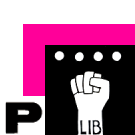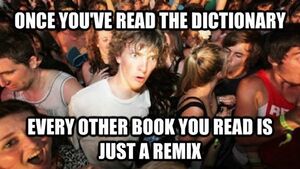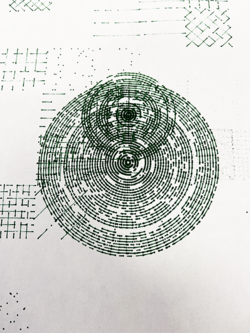User:Zuhui//Glossary
Glossary protocols
- always start with dry definitions on the top
- state or link the source on the left
- when quoting the source, always use the quotation marks and put a source number
- separate paraphrased content from direct quotes, use a var or dotted bar for separation
Paraphrasing guidelines
🌱Lidia's tip🌳
- always use your own words (it is helpful to look for synonyms of the original word; use a thesaurus:
https://www.thesaurus.com/
https://www.freethesaurus.com/
- don't paraphrase jargon, specialized words, technical terms
- pay attention to information flow: e.g.: old to new
- try to use transition devices (e.g. 'due to', 'however') -> find the important points and find the relation between them
C
Clinamen
Constraint
Curse
❶Understanding Curses: History, Cultural Significance, and Psychological Impact
📖 Victor Turner's Ritual process (KR)
📑 The Dramatic Function of the Curse in Shakespeare’s Richard III (KR)
❶
"A curse is generally defined as a solemn utterance intended to invoke a supernatural power to bring about harm or punishment. It can take various forms, including verbal incantations, written texts, or symbolic gestures.
Curses often arise in contexts of personal conflict, jealousy, or revenge, representing a way for individuals to express their anger or frustration when conventional means of redress are insufficient."
D
Dialogic Image
F
Family Tree
Flow Chart
J
Jokes
L
Luddites
M
Mark-making
❶
"In art, mark making is a term used to describe the different lines, patterns, and textures that are made visible as a manifestation of applied or gestural energy. It is the gestural “language” of the artist, and it is a term that can refer to any art material applied to any surface. Mark making happens not only with paint on canvas or pencil on paper but in every form of expressive drawing. Aside from what these marks may add to a painting they possess unique characteristics that have the power to identify artists, almost as fingerprints do, to art aficionados."
- put differently, it's the artist’s bodily language translated onto a surface. A brushstroke, or any other stroke, carries intention, spontaneity, hesitation and the felt experiences of the artist. In this way, the mark becomes both the meaning and the vessel holding it.
N
Nomenclature
Non-linear Narrative
Nonsense
O
Organising-without-organisation
P
Peekaboo
❶ Wikipedia/Peekaboo
❷ BBC/Why all babies love peekaboo
❸ Wikipedia/If a tree falls in a forest and no one is around to hear it, does it make a sound?
❶
Peekaboo (or peek-a-boo) is a simple interactive game played with infants, in which one participant hides their face or body and then suddenly reveals themselves while exclaiming “Peekaboo!” The game is often used to engage infants and stimulate their cognitive and social development. It is associated with the concept of object permanence, as young infants do not yet understand that hidden objects still exist.
❷
Object permanence
according to Swiss phycologist Jean Piaget, babies spend their first two years figuring out something called object permanence -- the idea that things still exist even when you can’t see them. At first, babies assume that if something disappears from view, it’s completely gone. But over time, as they experience things coming back again and again, they start to understand that objects (and people) don’t just vanish.
peekaboo is also about understanding patterns and expectations. according to the study, the fact that they find the predictable version funnier suggests that human thinking isn’t just about discovering new things; it thrives on stability and pattern recognition.
- ↳ this applies to adults, too. The reason we feel comfortable in our daily lives isn’t just because things are familiar, but because we trust that the world follows consistent rules. Peekaboo, in its simplest form, helps babies understand this idea early on.
Things that are out of sight still exists
this idea that something can be out of sight but still exist, goes beyond childhood learning.
- do things exist even if we haven’t personally experienced them?
- when something disappears from the sight, is it really gone?
- what about time, relationships, emotions, or beliefs? do they persist even when we can’t actively see or feel them?
이 원리는 인간이 신뢰, 사랑, 기억, 그리고 존재 자체를 이해하는 방식과 연결된다. 우리가 물리적으로 보지 못하는 사람도 존재하고, 한때 있었던 감정이나 기억도 사라지는 것이 아니라 지속될 수 있으며, 우리의 경험 너머에도 세계는 계속해서 굴러간다는 개념이 여기에 포함된다.
you can say that peekaboo is connected to the most fundamental way humans understand the world. We continuously see things, lose them, and rediscover them, developing our thinking through this process.
❸
If a tree falls in a forest and no one is around to hear it, does it make a sound?
- the relationship between objective reality and subjective experience
- we constantly move between the stance of "“existence cannot be certain without experience” and “existence is acknowledged regardless of experience.”
Is belief possible without experience
Since we can’t personally experience everything in the world, belief becomes essential. without belief that goes beyond our experience, we would not be able to fully navigate the world.
- ↳belief isn’t something fixed forever—it constantly shifts and evolves.
- ↳We can never fully experience the world, nor can we blindly believe everything. But we navigate life by continuously choosing what to trust and what to question along the way.
- ↳our way of understanding the world stands on a balance between belief and experience.
Performativity
❶ Wikipedia/Performativity
❷ Wikipedia/Performative Utterance
📖 Keywords for Radicals
📑 Looking back and not behind
❶
Performativity is the concept that language, actions, and behaviors not only describe reality but actively contribute to the construction and reinforcement of social realities through enactment within a given cultural or institutional context.
J.L.Austin
❷
"In the philosophy of language and speech acts theory, performative utterances are sentences which not only describe a given reality, but also change the social reality they are describing."
Austin argued against a positivist philosophical claime that every statement could be judged as either true or false. To counter this idea, he pointed out examples of sentences that can’t be evaluated that way, such as:
- Nonsensical sentences
- Questions (interrogatives)
- Commands (directives)
- Ethical statements (“ethical” propositions)
To explain these exceptions, he introduced the concepts of performative sentences and illocutionary acts --cases where saying something is actually doing something, rather than just stating facts.
❶
- Illocutionary Acts
- locution 말하기 : the actual words spoken, that which the linguists and linguistic philosophers of the day were mostly interested in analyzing
- illocutionary force 행위 : what the speaker is attempting to do in uttering the locution
- perlocutionary effect 효과 : the actual effect the speaker actually has on the interlocutor by uttering the locution
- Utterance
- In Austin's theory, an utterance isn’t just about saying something-it’s about doing something through speech. He argued that when we speak, we’re not always just sharing information or describing facts; sometimes, the act of speaking itself performs an action. for example:
- saying "I do" at wedding performs the act of getting married.
- saying "I'm sorry" isn’t just making a sound, it’s doing the act of apologizing.
- in these cases of illocutionary acts. an utterance isn’t just noise or words-it’s a performance that creates a specific social or behavioral outcome.
Judith Butler
❶
The receiving side
❷
"Kent Bach and Robert Harnish claimed that performatives are successful only if recipients infer the intention behind the literal meaning, and that therefore the success of the performative act is determined by the receiving side."
Pretty Good Privacy (PGP)
S
Self-reflexive feedback loop
❶ 📖 My website is a shifting house next to a river of knowledge
❷Wikipedia/ Reflexivity(social theory)
❸roadmunk(?)/Feedback-loop
A continuous cycle of self-reflection and influence, where you keep looking back at yourself, and that process keeps shaping you in return.
❶
Self-Reflexive Feedback Loop refers a process of mutual influence that occurs between the act of building and maintaining a website and its creator.
As the creator builds the website, they reflect their identity and creative intentions into it. Over time, as they manage and interact with the site, its structure and functionality begin to influence the creator’s way of thinking and perspective.
This reflection leads to further changes, with the creator’s evolving identity and perspective is once again woven back into the website. It’s a back-and-forth process that keeps repeating.
Reflexivity
❷
"In epistemology, and more specifically, the sociology of knowledge:
reflexivity refers to circular relationships between cause and effect, especially as embedded in human belief structures. A reflexive relationship is multi-directional when the causes and the effects affect the reflexive agent in a layered or complex sociological relationship. The complexity of this relationship can be furthered when epistemology includes religion."
"Within sociology:
more broadly—the field of origin—reflexivity means an act of self-reference where existence engenders examination, by which the thinking action "bends back on", refers to, and affects the entity instigating the action or examination. It commonly refers to the capacity of an agent to recognise forces of socialisation and alter their place in the social structure. A low level of reflexivity would result in individuals shaped largely by their environment (or "society"). A high level of social reflexivity would be defined by individuals shaping their own norms, tastes, politics, desires, and so on. This is similar to the notion of autonomy. (See also structure and agency and social mobility.)"
- 반사성은 원인과 결과 간의 순환적 관계를 의미하며, 특히 인간의 신념 구조에 내재된 방식으로 나타난다. 즉, 특정한 믿음이 행동을 유발하고, 그 행동이 다시 믿음을 강화하거나 변화시키는 자기참조적인 관계를 뜻한다.
- ↳ 반사적 관계는 다방향적일 수 있는데, 이는 원인과 결과가 단순히 일방적으로 작용하는 것이 아니라, 반사적 행위자에게 영향을 주고, 그 행위자가 다시 원인과 결과에 영향을 미치는 방식으로 작동하기 때문이다. 이러한 관계가 사회학적으로 다층적이고 복잡한 방식으로 형성될 때, 반사성의 수준이 더욱 심화된다.
- ↳ 이는 존재자체가 스스로를 반성적으로 탐구하게 만드는 과정을 가리키며, 이 과정에서 사고라는 행위가 ‘자신을 향해 구부러지듯이’ 되돌아가면서, 그 사고를 유발한 주체를 다시 반영하고 영향을 미치는 현상을 뜻한다.
- ↳ 반사성이란 개인이 자신의 행동과 사고를 돌아보고, 그것이 형성된 사회적 요인을 인식하며, 이를 바탕으로 자신이 사회 구조에서 차지하는 위치를 변화시킬 수 있는 능력을 의미한다.
- 낮은 수준의 반사성을 가진 개인은
- → 사회화의 힘에 의해 형성된 환경(또는 ‘사회’)에 의해 크게 영향을 받고, 자신을 둘러싼 사회 구조를 그대로 받아들이는 경향이 있다.
- 높은 수준의 반사성을 가진 개인은
- → 자신을 둘러싼 사회적 규범, 가치관, 정치적 입장, 욕망 등을 스스로 형성하고 변화시키는 능력을 갖게 된다(이는 자율성 개념과 유사한 개념이다).
Reflexivity in connection to Performativity
- they both contributes to how the reality is being formed
- ↳ that reality is not a fixed thing, it is constructed and reshaped through reflective thoughts and actions in an ongoing process.
the difference is that reflexivity is about realizing and questioning the given reality. where as performativity is about acting(repeatedly) in ways that reinforce or reshape that reality.
- ↳ together, they drive change.
Feedback loop
❸
"A Feedback Loop is a process in which information about the output of a system, process, or activity is returned to the input to modify or reinforce the actions being taken."
"A Feedback Loop is a mechanism that helps a system self-regulate and adapt by using feedback. This cycle involves taking action, monitoring the results, analyzing the outcomes, and then making adjustments based on that feedback before retaking action. This continual process ensures systems can adjust and optimize their performance over time."
Virtous, Self-perfecting loop
❶
Side Narrative
Subliminal Messasing
Sybil attack
T
Trust
W
Wallflower


